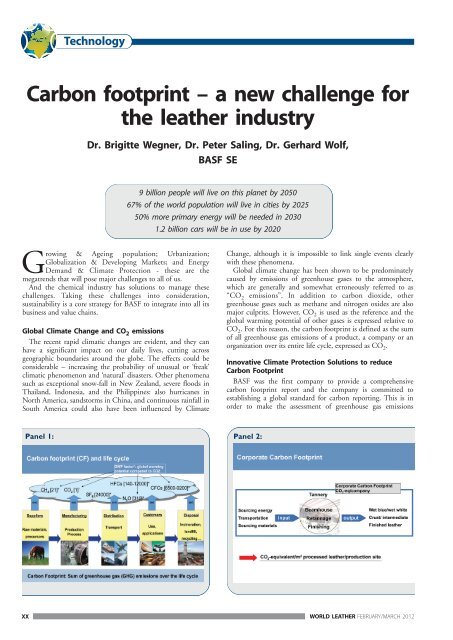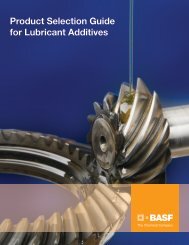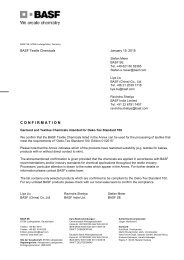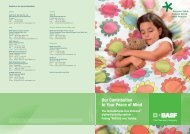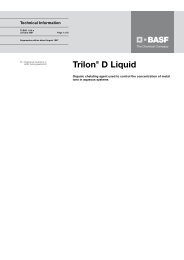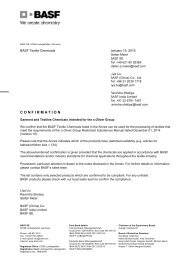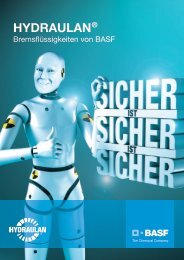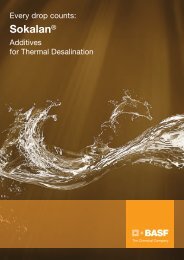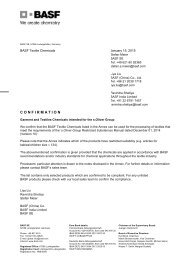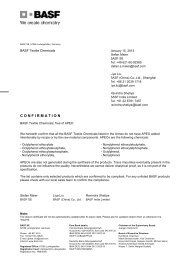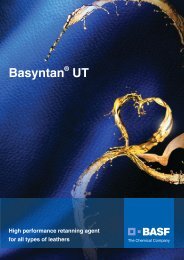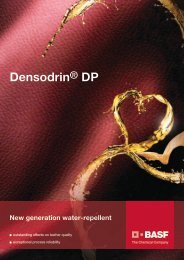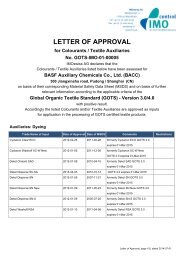Carbon footprint – a new challenge for the leather industry
Carbon footprint – a new challenge for the leather industry
Carbon footprint – a new challenge for the leather industry
Create successful ePaper yourself
Turn your PDF publications into a flip-book with our unique Google optimized e-Paper software.
Technology<br />
<strong>Carbon</strong> <strong>footprint</strong> <strong>–</strong> a <strong>new</strong> <strong>challenge</strong> <strong>for</strong><br />
<strong>the</strong> lea<strong>the</strong>r <strong>industry</strong><br />
Dr. Brigitte Wegner, Dr. Peter Saling, Dr. Gerhard Wolf,<br />
BASF SE<br />
9 billion people will live on this planet by 2050<br />
67% of <strong>the</strong> world population will live in cities by 2025<br />
50% more primary energy will be needed in 2030<br />
1.2 billion cars will be in use by 2020<br />
Growing & Ageing population; Urbanization;<br />
Globalization & Developing Markets; and Energy<br />
Demand & Climate Protection - <strong>the</strong>se are <strong>the</strong><br />
megatrends that will pose major <strong>challenge</strong>s to all of us.<br />
And <strong>the</strong> chemical <strong>industry</strong> has solutions to manage <strong>the</strong>se<br />
<strong>challenge</strong>s. Taking <strong>the</strong>se <strong>challenge</strong>s into consideration,<br />
sustainability is a core strategy <strong>for</strong> BASF to integrate into all its<br />
business and value chains.<br />
Global Climate Change and CO 2 emissions<br />
The recent rapid climatic changes are evident, and <strong>the</strong>y can<br />
have a significant impact on our daily lives, cutting across<br />
geographic boundaries around <strong>the</strong> globe. The effects could be<br />
considerable <strong>–</strong> increasing <strong>the</strong> probability of unusual or ‘freak’<br />
climatic phenomenon and ‘natural’ disasters. O<strong>the</strong>r phenomena<br />
such as exceptional snow-fall in New Zealand, severe floods in<br />
Thailand, Indonesia, and <strong>the</strong> Philippines: also hurricanes in<br />
North America, sandstorms in China, and continuous rainfall in<br />
South America could also have been influenced by Climate<br />
Change, although it is impossible to link single events clearly<br />
with <strong>the</strong>se phenomena.<br />
Global climate change has been shown to be predominately<br />
caused by emissions of greenhouse gases to <strong>the</strong> atmosphere,<br />
which are generally and somewhat erroneously referred to as<br />
“CO 2 emissions”. In addition to carbon dioxide, o<strong>the</strong>r<br />
greenhouse gases such as methane and nitrogen oxides are also<br />
major culprits. However, CO 2 is used as <strong>the</strong> reference and <strong>the</strong><br />
global warming potential of o<strong>the</strong>r gases is expressed relative to<br />
CO 2 . For this reason, <strong>the</strong> carbon <strong>footprint</strong> is defined as <strong>the</strong> sum<br />
of all greenhouse gas emissions of a product, a company or an<br />
organization over its entire life cycle, expressed as CO 2 .<br />
Innovative Climate Protection Solutions to reduce<br />
<strong>Carbon</strong> Footprint<br />
BASF was <strong>the</strong> first company to provide a comprehensive<br />
carbon <strong>footprint</strong> report and <strong>the</strong> company is committed to<br />
establishing a global standard <strong>for</strong> carbon reporting. This is in<br />
order to make <strong>the</strong> assessment of greenhouse gas emissions<br />
Panel 1: Panel 2:<br />
XX<br />
WORLD LEATHER FEBRUARY/MARCH 2012
Technology<br />
generated by companies along <strong>the</strong> value creation chain<br />
in<strong>for</strong>mative, practical and uni<strong>for</strong>m.<br />
In 2010, BASF achieved significant reductions in greenhouse<br />
gas emissions from its own production from 31.1 million tons in<br />
2009 to 25.2 million tons in 2010. The company’s innovative<br />
climate protection solutions across all industries helped<br />
customers to reduce <strong>the</strong>ir CO 2 <strong>footprint</strong> by 322 million tons.<br />
In principle, every branch of <strong>industry</strong> is affected by discussions<br />
concerning carbon <strong>footprint</strong>s, but <strong>the</strong> automotive <strong>industry</strong> is in<br />
<strong>the</strong> focus of <strong>the</strong>se <strong>challenge</strong>s. Internal combustion engines are<br />
responsible <strong>for</strong> a large proportion of CO 2 emissions. This is<br />
reflected in <strong>the</strong> ef<strong>for</strong>ts of many motor manufacturers to develop<br />
alternative means of propulsion that are as close as possible to<br />
being carbon neutral. If <strong>the</strong> whole automotive value chain is<br />
analyzed, it can be estimated that approximately 80% of <strong>the</strong><br />
carbon <strong>footprint</strong> is accounted <strong>for</strong> in <strong>the</strong> active use phase, that is,<br />
when <strong>the</strong> vehicle is being driven. Five percent of carbon<br />
emissions are generated when <strong>the</strong> vehicle is disposed of and 15%<br />
when it is manufactured.<br />
In Germany and some o<strong>the</strong>r countries, manufacturers already<br />
in<strong>for</strong>m consumers about <strong>the</strong> CO 2 that is emitted in <strong>the</strong> active use<br />
phase in g CO 2 per km. In future, motor manufacturers will<br />
collect in<strong>for</strong>mation on <strong>the</strong> CO 2 emissions of all <strong>the</strong> components<br />
and <strong>the</strong>y will need to request this in<strong>for</strong>mation from <strong>the</strong>ir<br />
suppliers. The lea<strong>the</strong>r <strong>industry</strong> will <strong>the</strong>re<strong>for</strong>e need to respond to<br />
<strong>the</strong> <strong>challenge</strong> of quantifying CO 2 emissions per m 2 of lea<strong>the</strong>r.<br />
Panel 3:<br />
Disposal of <strong>the</strong> hides generates additional CO 2 emissions and<br />
utilizing <strong>the</strong>m to manufacture lea<strong>the</strong>r products <strong>for</strong> o<strong>the</strong>r<br />
applications would be a more sustainable alternative.<br />
There are different approaches to evaluate <strong>the</strong> carbon <strong>footprint</strong><br />
of lea<strong>the</strong>r articles. One approach would be to determine <strong>the</strong><br />
carbon <strong>footprint</strong> of every type of lea<strong>the</strong>r manufactured by <strong>the</strong><br />
tannery. This method is cumbersome and requires a lot of time<br />
and ef<strong>for</strong>t, which makes it unfeasible. Ano<strong>the</strong>r approach is <strong>the</strong><br />
cradle-to-grave approach, which is to per<strong>for</strong>m an entire lifecycle<br />
assessment, covering all <strong>the</strong> stages of <strong>the</strong> product life from raw<br />
material to disposal. This approach is complicated and<br />
impractical <strong>for</strong> use in <strong>the</strong> lea<strong>the</strong>r <strong>industry</strong>.<br />
Currently, <strong>the</strong> most practicable solution would be to calculate<br />
<strong>the</strong> corporate carbon <strong>footprint</strong> (CCF) by measuring <strong>the</strong><br />
greenhouse gases emitted at each production site, <strong>the</strong>n expressed<br />
as <strong>the</strong> CO 2 equivalent. This figure can <strong>the</strong>n be expressed relative<br />
to <strong>the</strong> surface area of <strong>the</strong> lea<strong>the</strong>r that is produced in <strong>the</strong> tannery.<br />
The final figure is an average <strong>for</strong> each production site, which is<br />
certainly enough to satisfy <strong>the</strong> requirements of <strong>the</strong> automotive<br />
<strong>industry</strong> and <strong>the</strong> shoe <strong>industry</strong>.<br />
The scope of <strong>the</strong> CCF has to be clearly defined, i.e. it needs to<br />
specify exactly which statistics from <strong>the</strong> production plant are<br />
included in <strong>the</strong> calculation. The German Lea<strong>the</strong>r Federation has<br />
developed a method (ECO 2 L-Label) which is currently being<br />
introduced. This offers tanners a ra<strong>the</strong>r simple means of<br />
measuring a clearly defined, standardized carbon <strong>footprint</strong>. The<br />
ECO 2 L-Label may be adopted as an international standard.<br />
The factors <strong>for</strong> determining <strong>the</strong> carbon <strong>footprint</strong> of<br />
lea<strong>the</strong>r<br />
In principle, a distinction needs to be made between three<br />
separate segments:<br />
1] The production of <strong>the</strong> lea<strong>the</strong>r in <strong>the</strong> tannery (see ECO 2 L-Label):<br />
In particular this includes <strong>the</strong> type and quantity of energy<br />
consumed in <strong>the</strong> tannery and in <strong>the</strong> transport and disposal of<br />
goods. This phase is well covered by <strong>the</strong> <strong>new</strong> label.<br />
2] The production of chemicals: This includes both <strong>the</strong> basic<br />
chemicals as well as <strong>the</strong> specialties that are applied to <strong>the</strong><br />
Panel 4:<br />
The <strong>Carbon</strong> Footprint<br />
Several different approaches can be taken to define and<br />
quantify <strong>the</strong> carbon <strong>footprint</strong> of lea<strong>the</strong>r. In principle, <strong>the</strong> carbon<br />
<strong>footprint</strong> of lea<strong>the</strong>r ought to be calculated <strong>for</strong> <strong>the</strong> whole of its<br />
lifecycle. Because lea<strong>the</strong>r is made from hide - which is obtained<br />
as a by-product of meat production - <strong>the</strong> carbon <strong>footprint</strong> of<br />
cattle-breeding needs to be taken into account, in particular, <strong>the</strong><br />
methane gas that is generated as a fermentation product in <strong>the</strong><br />
digestive systems of ruminants.<br />
Because <strong>the</strong> raw hide is clearly a by-product of <strong>the</strong> production<br />
of meat and milk, it is not directly responsible <strong>for</strong> <strong>the</strong> methane<br />
that is emitted as <strong>the</strong> result of raising cattle.<br />
Never<strong>the</strong>less, it has not yet been clearly defined how <strong>the</strong>se<br />
emissions should be allocated in <strong>the</strong> production of lea<strong>the</strong>r.<br />
WORLD LEATHER FEBRUARY/MARCH 2012<br />
XX
Technology<br />
lea<strong>the</strong>r during <strong>the</strong> manufacturing process. Theoretically, <strong>the</strong><br />
individual carbon <strong>footprint</strong> of each chemical substance would<br />
have to be quantified and <strong>the</strong>n expressed relative to <strong>the</strong> area of<br />
<strong>the</strong> lea<strong>the</strong>r. This would require a tedious ef<strong>for</strong>t and would<br />
involve high costs because of <strong>the</strong> large number of different<br />
chemical products that are applied. There<strong>for</strong>e this is not <strong>the</strong><br />
most ideal approach.<br />
Panel 6:<br />
Accordingly, studies are currently being conducted at BASF to<br />
find a pragmatic solution to assess <strong>the</strong> influence of chemicals on<br />
<strong>the</strong> corporate carbon <strong>footprint</strong> objectively. Generally, it can be<br />
assumed that modifying <strong>the</strong> production process by following <strong>the</strong><br />
recommendations below will have a positive effect on <strong>the</strong> carbon<br />
<strong>footprint</strong> of chemical substances.<br />
• Optimized production of processes chemicals.<br />
• Production processes in <strong>the</strong> tannery should be continually<br />
revised and modified in order to reduce water and energy<br />
consumption.<br />
3] The use phase: This relates to <strong>the</strong> CO 2 that is emitted during<br />
<strong>the</strong> working life of <strong>the</strong> lea<strong>the</strong>r. We need to work very closely<br />
with <strong>the</strong> automotive manufacturers to get this in<strong>for</strong>mation.<br />
At <strong>the</strong> moment, we do not have all <strong>the</strong> in<strong>for</strong>mation necessary<br />
to get an absolute figure <strong>for</strong> <strong>the</strong> CO 2 emissions from lea<strong>the</strong>r and<br />
how <strong>the</strong>se three loosely defined segments - production, chemicals<br />
and use - interact. However, it can be assumed that <strong>the</strong> results<br />
can vary widely from tannery to tannery depending on <strong>the</strong> type<br />
of energy that is used (fossil fuels or regenerative energy) and <strong>the</strong><br />
manufacturing process.<br />
Wider ecological issues<br />
If we consider <strong>the</strong> lea<strong>the</strong>r within a much wider context, such<br />
as <strong>the</strong> ecological fingerprint, most of <strong>the</strong> relevant environmental<br />
factors do not relate directly with <strong>the</strong> carbon <strong>footprint</strong>. This is<br />
because <strong>the</strong> carbon <strong>footprint</strong> primarily covers airborne emissions<br />
that are caused by <strong>the</strong> consumption of energy. Fur<strong>the</strong>rmore, <strong>the</strong><br />
absolute figures <strong>for</strong> <strong>the</strong> quantity of energy consumed do not<br />
Panel 5:<br />
necessarily correlate with <strong>the</strong> CO 2 emissions.<br />
Clearly, <strong>the</strong> first step is to evaluate <strong>the</strong> source of energy (fossil,<br />
regenerative, CO 2 neutral) be<strong>for</strong>e <strong>the</strong> CO 2 emissions can be<br />
calculated. But we should also be mindful of <strong>the</strong> fact that<br />
whenever carbon <strong>footprint</strong> values are used, <strong>the</strong>re are o<strong>the</strong>r<br />
“emissions” that play an important role in <strong>the</strong> production. In<br />
addition to CO 2 this includes wastewaters and solid waste: many<br />
different aspects have to be considered when <strong>the</strong> sustainability of<br />
a product or a process is evaluated.<br />
The sustainability of lea<strong>the</strong>r<br />
A distinction has been made between three separate segments<br />
where <strong>the</strong> sustainability of lea<strong>the</strong>r can be assessed.<br />
Apart from <strong>the</strong> carbon <strong>footprint</strong>, which is essentially<br />
concerned with energy use, sustainability needs to take o<strong>the</strong>r<br />
issues into account. This includes water management - water<br />
consumption and effluent treatment - and toxicity, and <strong>the</strong><br />
presence of harmful substances (RS = restricted substances).<br />
Theoretically, it would be possible to produce lea<strong>the</strong>r with an<br />
optimum carbon <strong>footprint</strong> but without adequate facilities <strong>for</strong><br />
treating <strong>the</strong> waste water: <strong>the</strong> lea<strong>the</strong>r might also contain large<br />
quantities of harmful substances. Hence, this lea<strong>the</strong>r would not<br />
fulfill <strong>the</strong> sustainability criteria. This is often overlooked when<br />
<strong>the</strong> lea<strong>the</strong>r value chain is assessed and <strong>the</strong> carbon <strong>footprint</strong> is<br />
used to emphasize <strong>the</strong> “green” credentials of <strong>the</strong> product. The<br />
wider environmental impact needs taking into account.<br />
In this context <strong>the</strong> carbon <strong>footprint</strong> is an important factor <strong>for</strong><br />
assessing <strong>the</strong> sustainability of lea<strong>the</strong>r production, but it is not <strong>the</strong><br />
only factor that has to be considered.<br />
Never<strong>the</strong>less, it is essential that an internationally recognized<br />
standard - a so called Product Category Rule (PCR) <strong>for</strong><br />
calculating carbon <strong>footprint</strong> values - is made available in order<br />
<strong>for</strong> a valid comparison to be made of <strong>the</strong> carbon <strong>footprint</strong>s of<br />
different tanneries.<br />
The lea<strong>the</strong>r <strong>industry</strong> needs to take an active approach to <strong>the</strong>se<br />
issues so that it can portray lea<strong>the</strong>r as being a sustainable product<br />
that has several environmental advantages. This is <strong>the</strong> only way<br />
to ensure that lea<strong>the</strong>r is a sustainable product that can continue<br />
to be marketed as a premium resource along <strong>the</strong> value chain.<br />
XX<br />
WORLD LEATHER FEBRUARY/MARCH 2012


